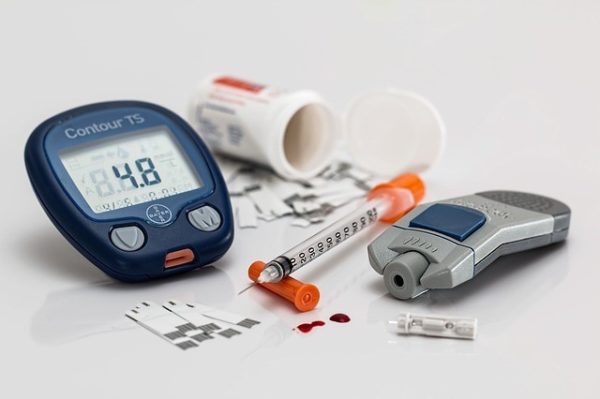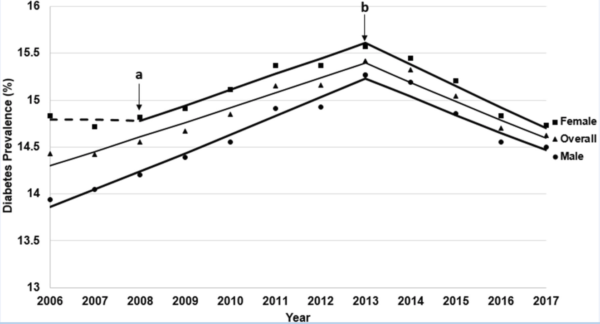
- Details
- By Rear Adm. Michael D. Weahkee
By Rear Adm. Michael D. Weahkee, IHS Director
ROCKVILLE, Md. — The prevalence of diagnosed diabetes in American Indian and Alaska Native adults decreased significantly from 2013 to 2017, according to a new study published in BMJ Open Diabetes Research and Care, a journal published by BMJ in partnership with the American Diabetes Association.
 Rear Admiral Michael D. Weahkee
Rear Admiral Michael D. Weahkee
After years of increasing, the percentage of American Indian and Alaska Native adults with diabetes consistently decreased from 15.4% in 2013 to 14.6% in 2017. This represents a 5.2% decrease in prevalence, which is the percentage of people with a condition.
This study documents the first known decrease in diabetes prevalence for American Indian and Alaska Native people. The study was led by Ann Bullock, director of the IHS Division of Diabetes Treatment and Prevention, and included researchers from the CDC Division of Diabetes Translation and the Department of Epidemiology and Biostatistics at Imperial College London.
This substantial decrease in diabetes prevalence is great news for American Indian and Alaska Native people and communities. It means that fewer American Indian and Alaska Native people have to live with diabetes and its complications, such as heart disease and kidney failure, and may also result in reduced health care costs. In addition, as diabetes is a risk factor for severe COVID-19 disease, this improvement in the health status of Native people is especially welcome.
Other key findings from this peer-reviewed article based on data from IHS and tribal health facilities include:
- Diabetes prevalence decreased for both men and women from 2013 to 2017 and for all age groups studied starting in 2013 or 2014 through 2017.
- Although results varied by geographic region, diabetes prevalence either decreased or leveled off in all regions.
- Diabetes prevalence for American Indian and Alaska Native adults remained higher in 2017 than that seen in other studies of the general US adult population and other racial/ethnic groups.
 Trends in age-adjusted prevalence of diagnosed diabetes among American Indian and Alaska Native adults aged 18 years and older in the Indian Health Service active clinical population, overall and by sex, 2006–2017. Notes: Y-axis does not start at 0. Data are from the Indian Health Service National Data Warehouse. Diabetes diagnosis determined by at least two encounters with a diabetes diagnosis code during the relevant year. Symbols are observed annual values; lines are modeled using JoinPoint Trend Analysis Software. Dotted lines indicate no significant trend; solid lines indicate a significant annual percentage change. Arrows indicate joinpoints (changes in trend): (a) applies to Female only; (b) applies to overall, female, and male.
Trends in age-adjusted prevalence of diagnosed diabetes among American Indian and Alaska Native adults aged 18 years and older in the Indian Health Service active clinical population, overall and by sex, 2006–2017. Notes: Y-axis does not start at 0. Data are from the Indian Health Service National Data Warehouse. Diabetes diagnosis determined by at least two encounters with a diabetes diagnosis code during the relevant year. Symbols are observed annual values; lines are modeled using JoinPoint Trend Analysis Software. Dotted lines indicate no significant trend; solid lines indicate a significant annual percentage change. Arrows indicate joinpoints (changes in trend): (a) applies to Female only; (b) applies to overall, female, and male.
Although it is not possible to determine specific reasons for these decreases, there are many potential contributors, including improvements in type 2 diabetes prevention services by IHS, tribal, and urban Indian health facilities. Key to these efforts is the Special Diabetes Program for Indians, commonly referred to as SDPI, which provides funding for type 2 diabetes prevention and diabetes treatment services to 301 programs in Native communities throughout the United States.
Diabetes prevalence in a population is primarily affected by diabetes diagnoses in a given time period and diabetes-related mortality. The decrease in prevalence seen in this study is especially noteworthy because it occurred at the same time that diabetes-related mortality in Native patients was also decreasing, suggesting the decrease was driven by fewer new cases of diabetes.
While we are encouraged by these positive outcomes, we know that there is still work to be done. The IHS will continue to include type 2 diabetes prevention and diabetes treatment among our highest priorities.
Related content:
Video: 2019 Diabetes in Indian Country Conference
Video: Changing the Course of Diabetes in Indian Country
Blog: Providing Diabetes Prevention, Education, and Treatment Services in Indian Country
Fact Sheet: Special Diabetes Program for Indians
More Stories Like This
Native News Weekly (August 25, 2024): D.C. BriefsUS Presidents in Their Own Words Concerning American Indians
Navajo Man Faces Vehicular Homicide Charge After Child Killed at Navajo Nation Christmas Parade
Next on Native Bidaské: Lumbee Tribal Chairman John Lowery
Suspected Drunk Driver Crashes into Parade in Kayenta on Navajo Nation, Killing 1 & Injuring 3 Others
Help us defend tribal sovereignty.
At Native News Online, our mission is rooted in telling the stories that strengthen sovereignty and uplift Indigenous voices — not just at year’s end, but every single day.
Because of your generosity last year, we were able to keep our reporters on the ground in tribal communities, at national gatherings and in the halls of Congress — covering the issues that matter most to Indian Country: sovereignty, culture, education, health and economic opportunity.
That support sustained us through a tough year in 2025. Now, as we look to the year ahead, we need your help right now to ensure warrior journalism remains strong — reporting that defends tribal sovereignty, amplifies Native truth, and holds power accountable.
 The stakes couldn't be higher. Your support keeps Native voices heard, Native stories told and Native sovereignty defended.
The stakes couldn't be higher. Your support keeps Native voices heard, Native stories told and Native sovereignty defended.
Stand with Warrior Journalism today.
Levi Rickert (Potawatomi), Editor & Publisher
